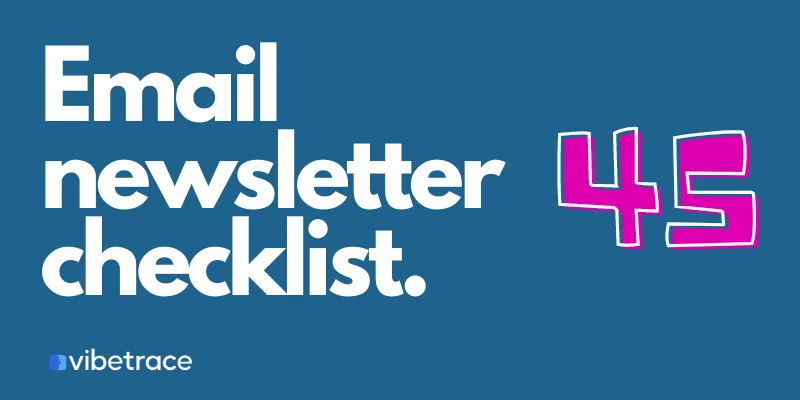Sending a newsletter can be easy in some cases, but it must also be effective. And to be effective you must consider this list.
As a business owner or marketing professional, email newsletters can be a valuable tool for staying in touch with your audience and promoting your products or services.
However, creating an effective newsletter takes more than just firing off a quick email.
We also have an infografic on this topic:
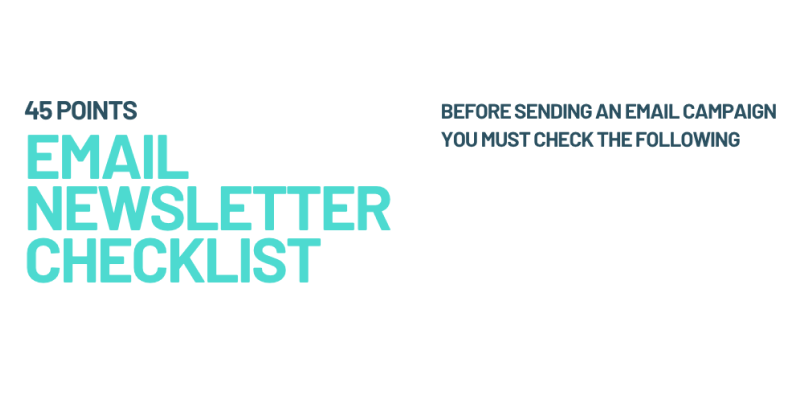
To ensure that your newsletters are well-received and achieve the results you desire, it’s important to follow an email newsletter checklist of best practices.
What is an Email Marketing Campaign?
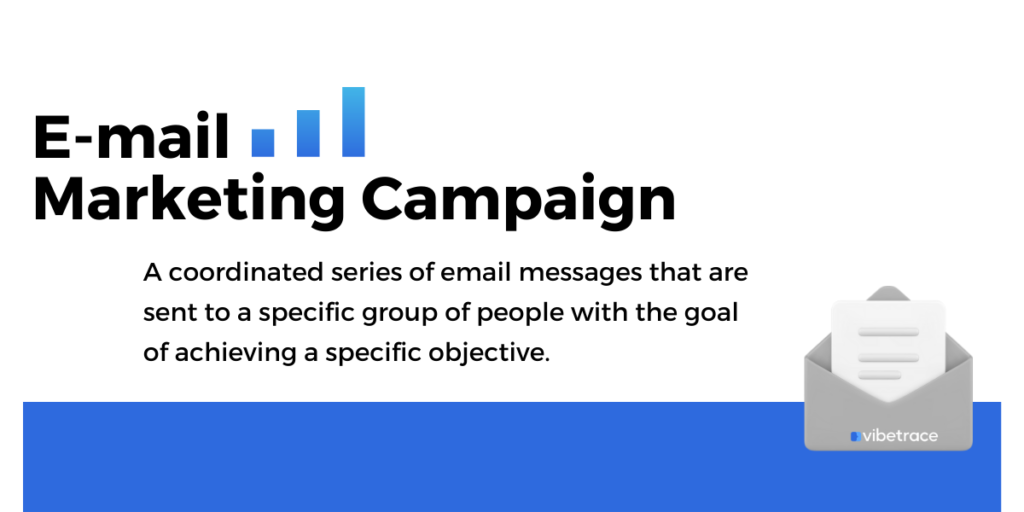
An email marketing campaign is a coordinated series of email messages that are sent to a specific group of people with the goal of achieving a specific objective.
Email marketing campaigns can be used for a variety of purposes, such as promoting a new product or service, building brand awareness, generating leads, or driving sales.
Email Newsletter Checklist
What is an email newsletter checklist?
An email newsletter checklist is a list of tasks or items to be completed or reviewed before sending an email newsletter.
The specific items on the checklist will vary depending on the needs and goals of your newsletter, as well as the preferences and policies of the organization sending the newsletter.
Do you like this article?
Join our CX for Retail dedicated newsletter!

Stay connected to what’s really important to optimize your digital revenues.
By clicking the button, you accept our Terms & Conditions. Also you will need to confirm your email address.
In every campaign, it requires you to be careful enough not to miss out on every detail you must consider to avoid sending wasted emails to your subscribers, so keep in mind the following Email Newsletter checklist you need to make sure of an effective marketing campaign.
Here are 45 points on the Email Newsletter Checklist to consider as you plan and execute your email newsletters that are divided into 6 categories such as:
- Campaign Information
- Recipients
- Email Message Content
- Advance configuration
- Email delivery
- Email Scheduling
Campaign Information
Campaign information includes the list of email addresses for your target audience, a series of email messages that align with your marketing goals, as well as the results of campaigns created, whether they are successful or not.
This category of the email newsletter checklist includes everything that is related to your campaign information.
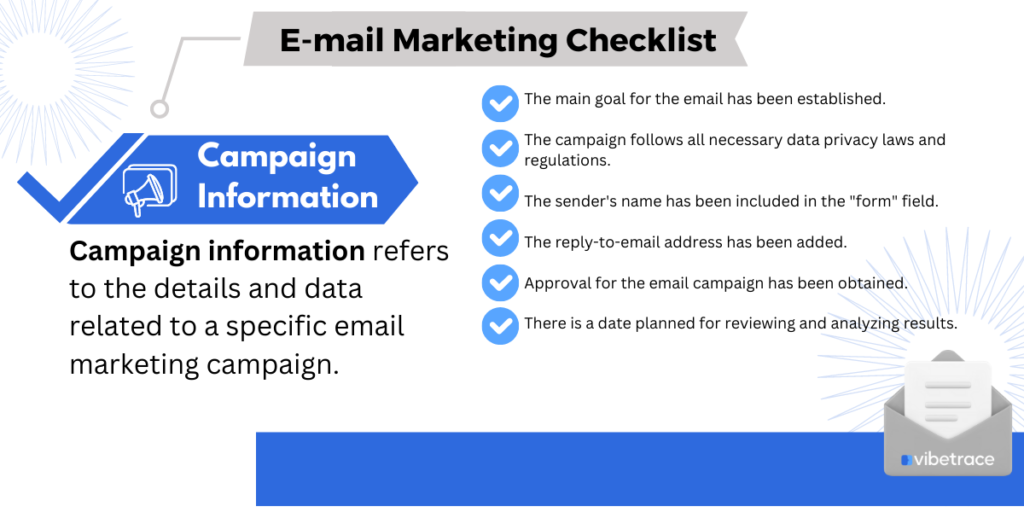
Here is the list of things you need to consider when checking if you have properly executed correct campaign information:
- The main goal for the email has been established. The purpose or objective of the email has been identified and is clear.
- The campaign follows all necessary data privacy laws and regulations. Your email must have been conducted in a legal and ethical manner.
- The sender’s name has been included in the “form” field. The sender’s name has been included in the designated field for the sender’s name, which is often called the “form” field which is typically displayed in the header of the email and helps the recipient identify who the email is from. In fact, This will help you establish credibility and identity.
- The reply-to-email address has been added. The reply-to email address is a field in an email message that specifies where replies to the message should be sent. By adding a reply-to email address, the sender is indicating that they would like to receive replies to the message at a specific email address, rather than at the address that the message was sent from.
- Approval for the email campaign has been obtained. This is important to ensure that the campaign is aligned with the organization’s goals and strategies and that it is conducted in a responsible and legal manner.
- There is a date planned for reviewing and analyzing results. A specific date must be scheduled for reviewing and analyzing the results of your campaign. This may involve reviewing metrics such as the number of email opens, clicks, conversions, or other performance indicators to assess the effectiveness of the campaign and identify areas for improvement.
There are common key elements that you must take note of in your email in accordance with your “campaign information checklist,” such as:
You must set clear objectives: What do you want to achieve with your campaign? Do you want to drive traffic to your website, generate leads, or promote a new product?
Make sure you follow rules: Have you understood all data privacy laws and regulations? What are the things you should do to avoid getting your email spammed?
You must develop a compelling message: What value do you offer to your target audience? How will your product or service solve their problems or meet their needs?
Always check for campaign status: Is your campaign approval taking so much time? How can an email campaign be obtained immediately?
Don’t forget to track and analyze your results: What email marketing software do you use to track key metrics like open rates, click-through rates, and conversions? What were the results of the campaign?
Recipients
Your Recipients are your target audience.
To make your email marketing efforts effective, it’s important to ensure that your emails are reaching the right audience. You can do this by managing various parameters, such as purging your email list periodically to prevent sending emails to inactive recipients.
This will help prevent your emails from being marked as spam. Remember, the recipients of your emails are the most important factor in the success of your email marketing campaign.
This category of the email newsletter checklist includes everything that is related to your recipients.
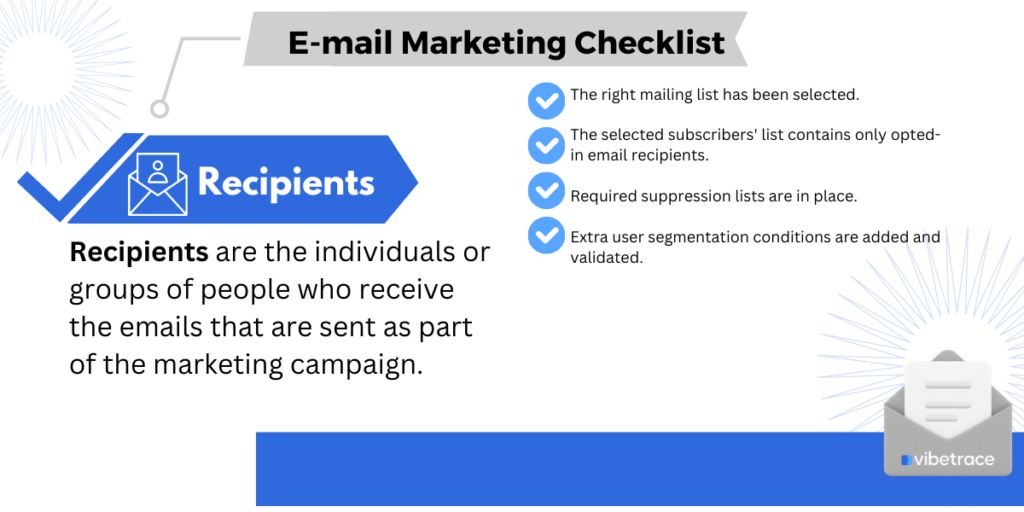
Here is the list of things you need to consider when checking if you have properly executed the correct recipients:
- The right mailing list has been selected. This is important to ensure that the campaign is targeted to the appropriate audience and has the best chance of achieving its desired outcomes. Also, to ensure that the list has been obtained legally and ethically and that it is up-to-date and accurate.
- The selected subscribers’ list contains only opted-in email recipients. Using only opted-in email recipients helps you to ensure that the campaign is targeted to individuals who are interested in hearing from your business and is more likely to be successful. It also helps to protect you from potential legal and reputational risks associated with sending unsolicited emails, which is often referred to as “spam.”
- Required suppression lists are in place. This is important to ensure that the campaign created is compliant with laws and regulations governing email marketing, and to respect the preferences of individuals who do not wish to receive communication from the organization.
- Extra user segmentation conditions are added and validated. Adding extra user segmentation conditions and validating them means identifying additional characteristics or interests that may be relevant for segmenting the list and ensuring that the segmentation is accurate and effective.
There are common key elements that you must take note of in your email in accordance with your “recipients checklist”, such as:
You must know your target audience: Who do you want to reach based on their needs, interests, and preferences? What are their genders or ages?
Use segmentation and personalization: Divide your email list into smaller groups based on factors like location, interests, or purchasing history, and personalize your emails with individual subscriber data.
Email Message Content
An email message content refers to the body of your email, which may include all text, images, and other media that is included in the message. The content of your email message is determined by the purpose of the email and the audience it is intended for.
For example, if the goal of the email is to drive traffic to a website or sell a product, the content of the message will be tailored to achieve these goals and be relevant to the target audience.
The content of an email message plays a crucial role in its effectiveness, as it determines how well the message will be received and understood by the recipient.
This category of the email newsletter checklist includes everything that is related to your email content.
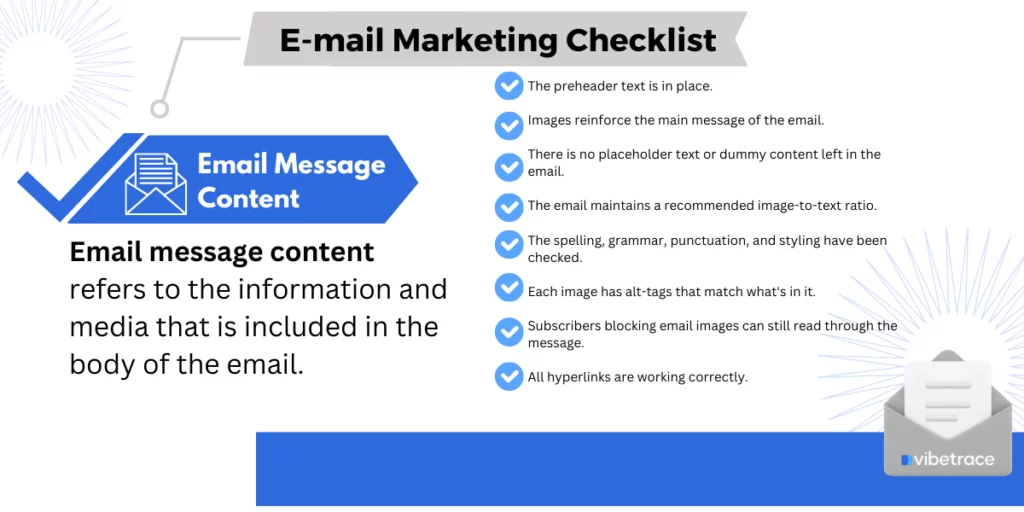
Here is the list of things you need to consider when checking if you have properly executed the right email message content:
- The preheader text is in place. The preheader text is an important element of an email, as it can influence whether the recipient decides to open the email or not.
- Images reinforce the main message of the email. By providing visual elements, images can help to make the email more engaging and appealing to the recipient and can help to convey the message more effectively.
- There is no placeholder text or dummy content left in the email. It is important to ensure that all placeholder text and dummy content is removed from the email before it is sent, as leaving this type of content in the email can be confusing or misleading for the recipient.
- The email maintains a recommended image-to-text ratio. If there are too many images in the email, it may be difficult for the recipient to understand the content, as the text may be difficult to read or may be overshadowed by the images.
- The spelling, grammar, punctuation, and styling have been checked. Checking these elements, it can help you ensure that the email is easy to understand and free of errors.
- Each image has alt-tags that match what’s in it. Alt-tags should accurately describe the content of the image and should match what is shown in the image
- Subscribers blocking email images can still read through the message. By including sufficient text and relevant alt-tags for the images, you can ensure that subscribers who have blocked images in their email can still read and understand the message.
- All hyperlinks are working correctly. If a hyperlink is not working correctly, it may prevent the recipient from accessing the desired information or resources, which can be frustrating and may negatively impact the effectiveness of the email.
- The subject line has no typos, is attention-grabbing and not misleading. This can help you to improve the effectiveness of the email and increase the chances that it will be opened and read by the recipient.
- The sentences are short and easy to scan, the paragraph is not long. This helps you to improve the clarity of the email, as it can make it easier for the recipient to understand the content.
- The email contains a clear main call-to-action. The main call-to-action should be prominently displayed and should be easy for the recipient to locate and use.
- Images that are supporting the call-to-action are correctly linked. If the image is not correctly linked, the recipient may be unable to take the desired action, which can reduce the effectiveness of the email.
- The email contains a physical address of the business and a contact method. This can help to improve the effectiveness of the email and make it easier for the recipient to connect with the business.
- Email recipients can easily identify all the links in the email. Links should be clearly labelled and should be visually distinct from the surrounding text so that the recipient can easily see and understand what they are for.
- The information in the email is accurate. If the information in the email is incorrect or misleading, it can damage the reputation of the sender and may cause the recipient to lose confidence in the business or organization.
- The email contains a valid unsubscribe link and an optional preference center. This is required by law in many countries and can help to ensure that the recipient’s privacy is respected. An optional preference center is a page or form that allows the recipient to customize their email preferences, such as the types of emails they receive or the frequency of emails.
- The email contains all the necessary disclaimers. This can help to protect your business and ensure that the email is compliant with laws and regulations.
- Email colors, fonts and aspects are consistent with your branding. By using consistent branding in the email, you can create a cohesive look and feel for your business, which can improve the effectiveness of the email and make it more memorable for the recipient.
- A plain-text version of the email is checked/amended. This may include adding alt-tags for images or other media or providing additional text to explain the content of the email.
- The social media bar has been added and the links are correct. The social media bar should be prominently displayed in the email and should include links to all relevant social media platforms that the business is active on.
There are common key elements that you must take note of in your email in accordance with your “email message content checklist”, such as:
Keep your email brief: Are your emails concise and to the point? How can you make it simple and proper as people are often busy and may not have time to read lengthy messages?
Use a clear and catchy subject line: Is the subject line clear and concise? How can the subject line accurately reflect the content of the email?
Looking for Subject Lines ideas? Here’s our topic regarding email subject lines.
Choose to personalize the email: Are you using the recipient’s name and other personal details? How can you make the email feel more personalized to increase the chances that it will be read?
Use proper formatting to make the message content easy to read: Do you use headings, bullet points, and short paragraphs to make the email easy to scan and understand?
Include a call to action: Do you give encouragement to the recipient to take a desired action, such as visiting a website or filling out a form?
Include a clear opt-out option: Do all your emails include a clear opt-out option for recipients who no longer wish to receive emails from you?
Here’s a checklist from an email tester:
- Subject and preheader are present and accurate
- Subject and preheader make sense with final design
- Coded email matches designed email
- Rendering properly in EOA previews (incl Dark Mode)
- Rendering properly on live desktop/mobile device
- Alt Text is present and accurate for all images
- Images display properly and load quickly
- Links functioning as expected, directing to live pages
- UTMs are appended correctly to all links
- Products shown/linked are in stock and available
- Unsubscribe link is present and functioning correctly
- (If Applicable) Personalization/fallbacks are correct
- (If Applicable) Offer is live
- (If Applicable) Disclaimer text is included and accurate
Check for spelling and grammar errors: Carefully proofread the email to ensure that it is free of errors.
Advanced Configuration
Advanced configuration generally refers to specialized settings or options that are available for configuring an email system or service. This could include various options for changing the way emails are sent, received, and even processed, as well as options for integrating the email system with other tools or services available.
Some examples of advanced configuration options for email systems might include the ability to set up custom domain names, check spam scores, configure server-side rules for managing incoming emails, or integrate the email system with other applications or platforms.
This category of the email newsletter checklist includes everything that is related to your email’s advanced configuration.
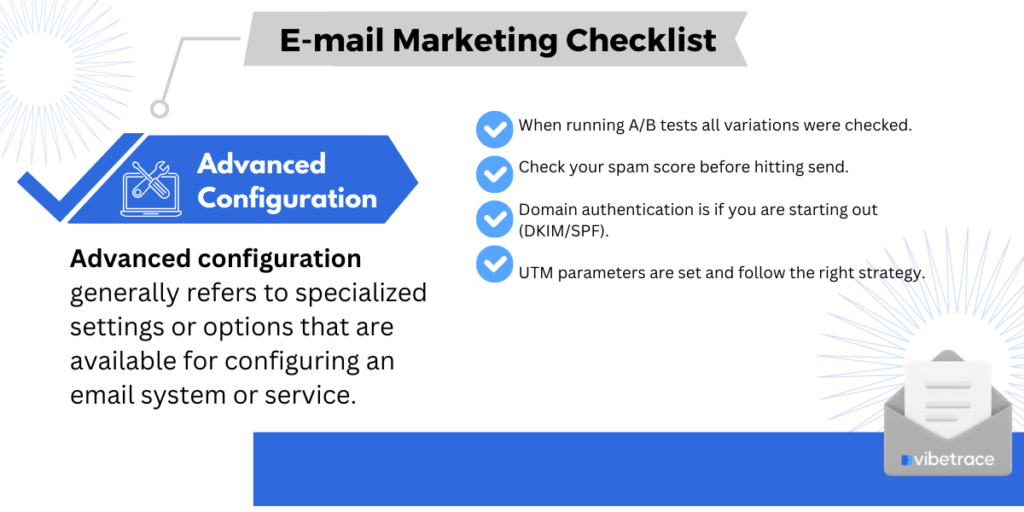
Here is the list of things you need to consider when checking if you have properly executed the advanced configuration of your email:
- When running A/B tests all variations were checked. This can help you to identify the best-performing email and make informed decisions about how to improve the effectiveness of your emails.
- Check your spam score before hitting send. This can help you ensure that the email is delivered to the recipient’s inbox and is more likely to be read and acted upon.
- Domain authentication is if you are starting out (DKIM/SPF). By setting up DKIM and SPF for your domain, you can help to ensure that your emails are more likely to be delivered to the recipient’s inbox and that they are perceived as more trustworthy.
- UTM parameters are set and follow the right strategy. UTM parameters can help you to understand how many clicks a link in the email received, where the clicks came from, and other important information.
There are common key elements that you must take note of in your email in accordance with your “advanced configuration checklist”, such as:
Check Authentication of the Domain: Do you usually check domain authentication? Have you set up custom domains?
Make sure that your newsletter is delivered: Were you able to ensure that your newsletter is being sent to the correct email addresses and that it is not being blocked or marked as spam?
Resolve issues in delivering emails: Do you actively seek out and try to fix problems that may be affecting the delivery of your emails?
Comply with rules and regulations: Have you been complying with laws and regulations, such as the requirement to include an opt-out option in emails?
Want to be up to date with Marketing?
Subscribe to our Retail CX newsletter!

Stay connected with what’s really important to optimize your digital revenues.
By clicking the button, you accept our Terms & Conditions. Also you will need to confirm your email address.
Email Delivery
Email delivery refers to the process of sending an email from the sender’s mail server to the recipient’s mail server.
When an email is sent, it is transmitted from the sender’s mail server to the recipient’s mail server over the internet, using a protocol such as SMTP (Simple Mail Transfer Protocol). The recipient’s mail server then receives the email and delivers it to the recipient’s email inbox.
This category of the email newsletter checklist includes everything that is related to the delivery of your emails.
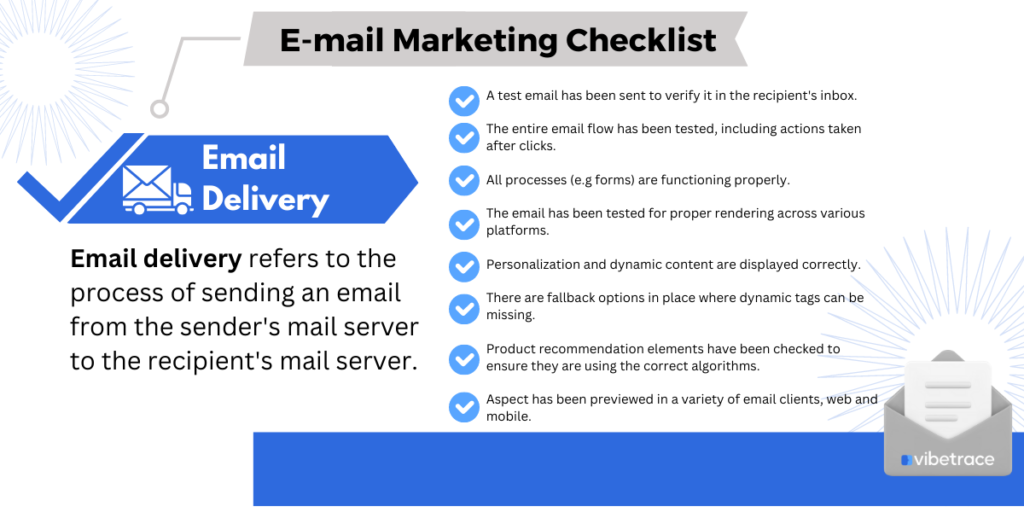
Here is the list of things you need to consider when checking if you have properly executed email delivery:
- A test email has been sent to verify it in the recipient’s inbox. When sending a test email, it is important to review the email carefully to ensure that it is accurate and effective, and to check for any errors or issues that may affect the deliverability or performance of the email.
- The entire email flow has been tested, including actions taken after clicks. This may include verifying that the email is delivered to the recipient’s inbox, that all links and buttons in the email are working correctly, and that any follow-up actions, such as filling out a form or making a purchase, are completed successfully.
- All processes (e.g forms) are functioning properly. If a process, such as a form, is not functioning correctly, it may be difficult or impossible for the recipient to complete the desired action, which can reduce the effectiveness of the email.
- The email has been tested for proper rendering across various platforms. This can help you to ensure that the email is effective and that it is easy for the recipient to read and use. This can improve the chances that the email will be read and acted upon by the recipient.
- Personalization and dynamic content are displayed correctly. You must review the email to ensure that the personalization and dynamic content are accurate and relevant to the recipient and that they are displayed in a way that is easy to read and understand.
- There are fallback options in place where dynamic tags can be missing. By having fallback options in place for missing dynamic tags, you can help to ensure that the email is displayed correctly and is useful and engaging for the recipient, even if the dynamic content is not available.
- Product recommendation elements have been checked to ensure they are using the correct algorithms. This can help you to ensure that the recommendations are accurate and relevant to the recipient.
- Aspect has been previewed in a variety of email clients, web and mobile. By previewing the aspect of the email on a variety of platforms, you can help to ensure that the email is effective and that it is easy for the recipient to read and use, regardless of the platform they are using.
There are common key elements that you must take note of in your email in accordance with your “email delivery checklist”, such as:
Test the email: Do you send a test version of the email to a small group of people to check for any issues before sending it to the full list?
Confirm that the email was sent to the correct recipients: Do you make sure that the email was sent to the intended recipients and that it was not accidentally sent to the wrong individual?
Review everything before the delivery of the email: Is your email compliant with all relevant laws and regulations? Have you checked all formatting, text previews, spelling and grammar errors, missing tags, and others?
Make sure forms and personalization are working: Do you check if emails you are sending are sent properly with working forms and links as well as personalized messages?
Check the delivery rate: Do you monitor the delivery rate to see how many of the emails were successfully delivered to your recipient’s inboxes?
Check the open rate: Do you monitor the open rate to see how many recipients opened the email?
Check the click-through rate: Do you monitor the click-through rate to see how many recipients clicked on links within the email?
Check for bounces and unsubscribes: Do you monitor the number of bounces (undelivered emails) and unsubscribes to see if there are any issues with the email list or delivery?
Scheduling
Email scheduling refers to the process of planning and organizing the timing of when emails will be sent as part of an email marketing campaign or other email communication.
Email scheduling can be used to send emails at a specific time or on a recurring basis, such as daily, weekly, or monthly.
Email scheduling is typically done using email marketing software or tools, which allow the sender to specify the date and time that the email should be sent, as well as any recurring schedule that should be followed.
This category of the email newsletter checklist includes everything that is related to the schedule of your email to recipients.
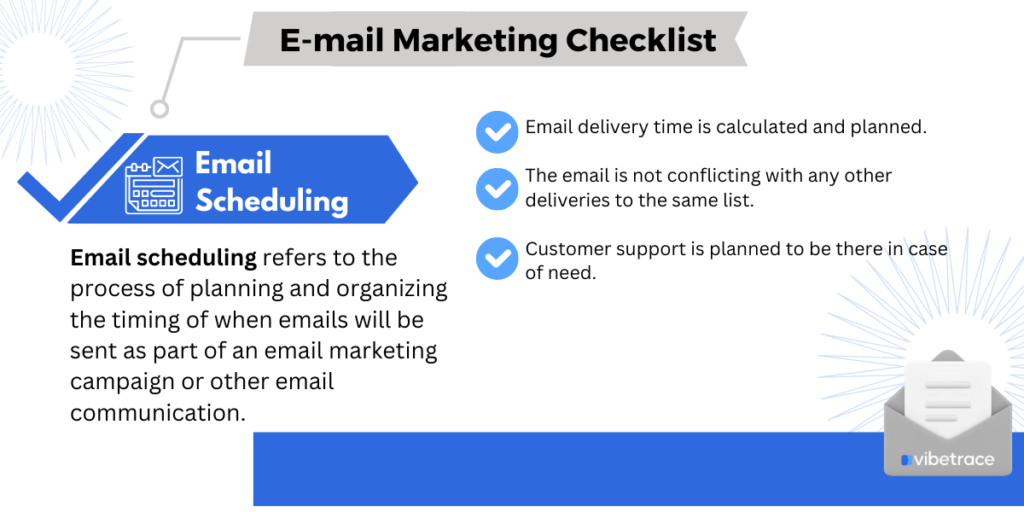
Here is the list of things you need to consider when checking if you have properly executed the email schedule:
- Email delivery time is calculated and planned. This can help you to ensure that the email is delivered at a time when the recipient is most likely to read and act upon it, which can improve its effectiveness.
- The email is not conflicting with any other deliveries to the same list. Sending multiple emails to the same list of recipients within a short period of time can be overwhelming for the recipient and may reduce the effectiveness of the emails.
- Customer support is planned to be there in case of need. You may involve having a customer support team available to respond to inquiries or issues related to the email, or providing resources, such as a FAQ or support center, to help the recipient find answers to their questions or resolve any issues they may be experiencing.
There are common key elements that you must take note of in your email in accordance with your “email scheduling checklist”, such as:
Plan your email schedule: Decide How often you will send your emails and what content you will include in each one.
Execute a well-planned email delivery: Have you created a list of all email deliveries? Will there be no clash and conflict in delivering emails to your mailing list?
Decide what to do with your customer support: Who will be there in case of emergency or queries from the target audience? How will you respond to them?
If you’re interested in buying the checklist as PDF, go to our Gumroad page.
Conclusion
An email newsletter checklist can serve as a guide to a successful and effective marketing campaign that will help you achieve your desired results although it requires extra effort to make it work.
Simply put, It ensures that all necessary tasks have been completed and that the newsletter is ready to be sent.
So start improving your campaigns now using an email newsletter checklist!

